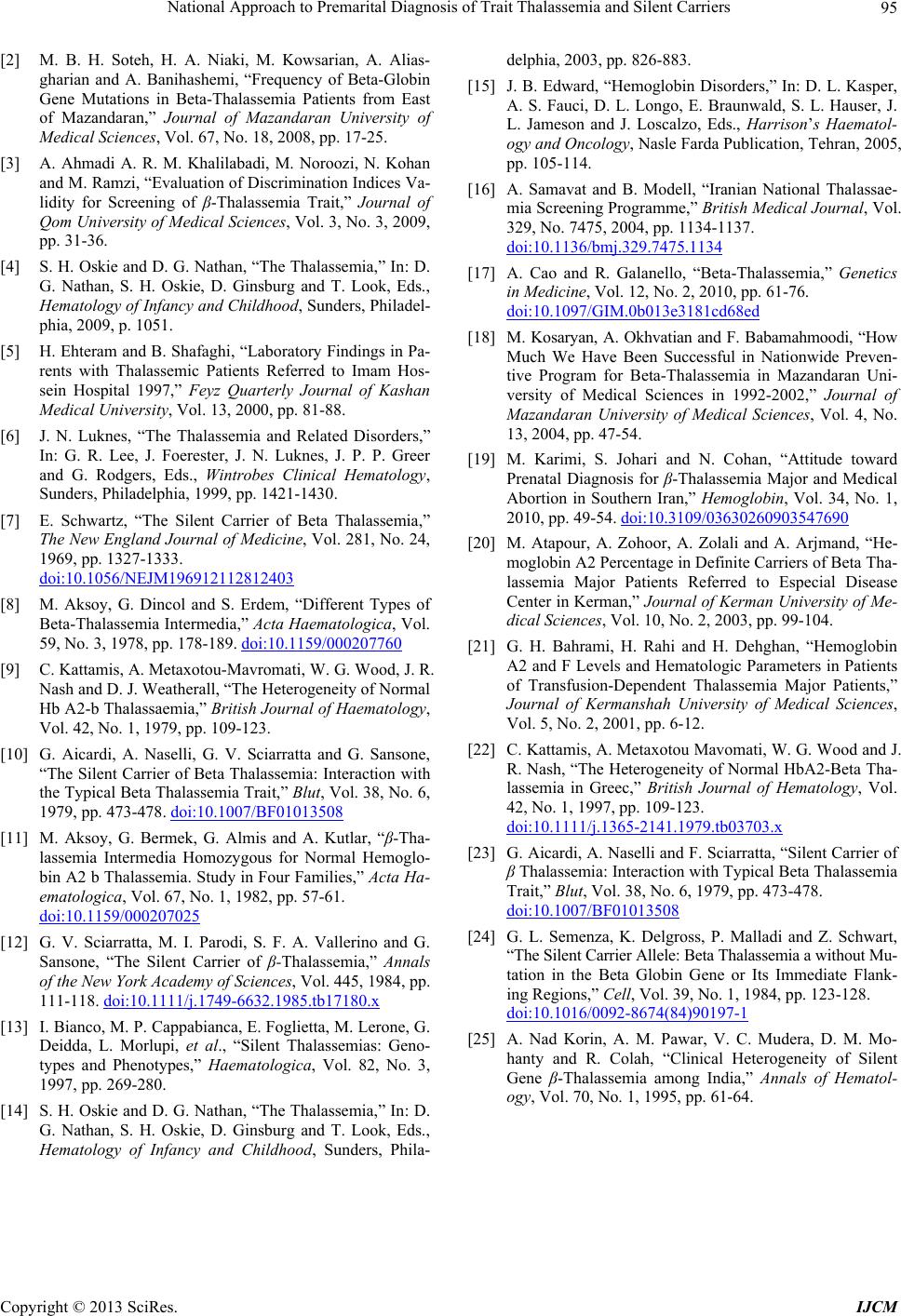
National Approach to Premarital Diagnosis of Trait Thalassemia and Silent Carriers 95
[2] M. B. H. Soteh, H. A. Niaki, M. Kowsarian, A. Alias-
gharian and A. Banihashemi, “Frequency of Beta-Globin
Gene Mutations in Beta-Thalassemia Patients from East
of Mazandaran,” Journal of Mazandaran University of
Medical Sciences, Vol. 67, No. 18, 2008, pp. 17-25.
[3] A. Ahmadi A. R. M. Khalilabadi, M. Noroozi, N. Kohan
and M. Ramzi, “Evaluation of Discrimination Indices Va-
lidity for Screening of β-Thalassemia Trait,” Journal of
Qom University of Medical Sciences, Vol. 3, No. 3, 2009,
pp. 31-36.
[4] S. H. Oskie and D. G. Nathan, “The Thalassemia,” In: D.
G. Nathan, S. H. Oskie, D. Ginsburg and T. Look, Eds.,
Hematology of Infancy and Childhood, Sunders, Philadel-
phia, 2009, p. 1051.
[5] H. Ehteram and B. Shafaghi, “Laboratory Findings in Pa-
rents with Thalassemic Patients Referred to Imam Hos-
sein Hospital 1997,” Feyz Quarterly Journal of Kashan
Medical University, Vol. 13, 2000, pp. 81-88.
[6] J. N. Luknes, “The Thalassemia and Related Disorders,”
In: G. R. Lee, J. Foerester, J. N. Luknes, J. P. P. Greer
and G. Rodgers, Eds., Wintrobes Clinical Hematology,
Sunders, Philadelphia, 1999, pp. 1421-1430.
[7] E. Schwartz, “The Silent Carrier of Beta Thalassemia,”
The New England Journal of Medicine, Vol. 281, No. 24,
1969, pp. 1327-1333.
doi:10.1056/NEJM196912112812403
[8] M. Aksoy, G. Dincol and S. Erdem, “Different Types of
Beta-Thalassemia Intermedia,” Acta Haematologica, Vol.
59, No. 3, 1978, pp. 178-189. doi:10.1159/000207760
[9] C. Kattamis, A. Metaxotou-Mavromati, W. G. Wood, J. R.
Nash and D. J. Weatherall, “The Heterogeneity of Normal
Hb A2-b Thalassaemia,” British Journal of Haematology,
Vol. 42, No. 1, 1979, pp. 109-123.
[10] G. Aicardi, A. Naselli, G. V. Sciarratta and G. Sansone,
“The Silent Carrier of Beta Thalassemia: Interaction with
the Typical Beta Thalassemia Trait,” Blut, Vol. 38, No. 6,
1979, pp. 473-478. doi:10.1007/BF01013508
[11] M. Aksoy, G. Bermek, G. Almis and A. Kutlar, “β-Tha-
lassemia Intermedia Homozygous for Normal Hemoglo-
bin A2 b Thalassemia. Study in Four Families,” Acta Ha-
ematologica, Vol. 67, No. 1, 1982, pp. 57-61.
doi:10.1159/000207025
[12] G. V. Sciarratta, M. I. Parodi, S. F. A. Vallerino and G.
Sansone, “The Silent Carrier of β-Thalassemia,” Annals
of the New York Academy of Sciences, Vol. 445, 1984, pp.
111-118. doi:10.1111/j.1749-6632.1985.tb17180.x
[13] I. Bianco, M. P. Cappabianca, E. Foglietta, M. Lerone, G.
Deidda, L. Morlupi, et al., “Silent Thalassemias: Geno-
types and Phenotypes,” Haematologica, Vol. 82, No. 3,
1997, pp. 269-280.
[14] S. H. Oskie and D. G. Nathan, “The Thalassemia,” In: D.
G. Nathan, S. H. Oskie, D. Ginsburg and T. Look, Eds.,
Hematology of Infancy and Childhood, Sunders, Phila-
delphia, 2003, pp. 826-883.
[15] J. B. Edward, “Hemoglobin Disorders,” In: D. L. Kasper,
A. S. Fauci, D. L. Longo, E. Braunwald, S. L. Hauser, J.
L. Jameson and J. Loscalzo, Eds., Harrison’s Haematol-
ogy and Oncology, Nasle Farda Publication, Tehran, 2005,
pp. 105-114.
[16] A. Samavat and B. Modell, “Iranian National Thalassae-
mia Screening Programme,” British Medical Journal, Vol.
329, No. 7475, 2004, pp. 1134-1137.
doi:10.1136/bmj.329.7475.1134
[17] A. Cao and R. Galanello, “Beta-Thalassemia,” Genetics
in Medicine, Vol. 12, No. 2, 2010, pp. 61-76.
doi:10.1097/GIM.0b013e3181cd68ed
[18] M. Kosaryan, A. Okhvatian and F. Babamahmoodi, “How
Much We Have Been Successful in Nationwide Preven-
tive Program for Beta-Thalassemia in Mazandaran Uni-
versity of Medical Sciences in 1992-2002,” Journal of
Mazandaran University of Medical Sciences, Vol. 4, No.
13, 2004, pp. 47-54.
[19] M. Karimi, S. Johari and N. Cohan, “Attitude toward
Prenatal Diagnosis for β-Thalassemia Major and Medical
Abortion in Southern Iran,” Hemoglobin, Vol. 34, No. 1,
2010, pp. 49-54. doi:10.3109/03630260903547690
[20] M. Atapour, A. Zohoor, A. Zolali and A. Arjmand, “He-
moglobin A2 Percentage in Definite Carriers of Beta Tha-
lassemia Major Patients Referred to Especial Disease
Center in Kerman,” Journal of Kerman University of Me-
dical Sciences, Vol. 10, No. 2, 2003, pp. 99-104.
[21] G. H. Bahrami, H. Rahi and H. Dehghan, “Hemoglobin
A2 and F Levels and Hematologic Parameters in Patients
of Transfusion-Dependent Thalassemia Major Patients,”
Journal of Kermanshah University of Medical Sciences,
Vol. 5, No. 2, 2001, pp. 6-12.
[22] C. Kattamis, A. Metaxotou Mavomati, W. G. Wood and J.
R. Nash, “The Heterogeneity of Normal HbA2-Beta Tha-
lassemia in Greec,” British Journal of Hematology, Vol.
42, No. 1, 1997, pp. 109-123.
doi:10.1111/j.1365-2141.1979.tb03703.x
[23] G. Aicardi, A. Naselli and F. Sciarratta, “Silent Carrier of
β Thalassemia: Interaction with Typical Beta Thalassemia
Trait,” Blut, Vol. 38, No. 6, 1979, pp. 473-478.
doi:10.1007/BF01013508
[24] G. L. Semenza, K. Delgross, P. Malladi and Z. Schwart,
“The Silent Carrier Allele: Beta Thalassemia a without Mu-
tation in the Beta Globin Gene or Its Immediate Flank-
ing Regions,” Cell, Vol. 39, No. 1, 1984, pp. 123-128.
doi:10.1016/0092-8674(84)90197-1
[25] A. Nad Korin, A. M. Pawar, V. C. Mudera, D. M. Mo-
hanty and R. Colah, “Clinical Heterogeneity of Silent
Gene β-Thalassemia among India,” Annals of Hematol-
ogy, Vol. 70, No. 1, 1995, pp. 61-64.
Copyright © 2013 SciRes. IJCM